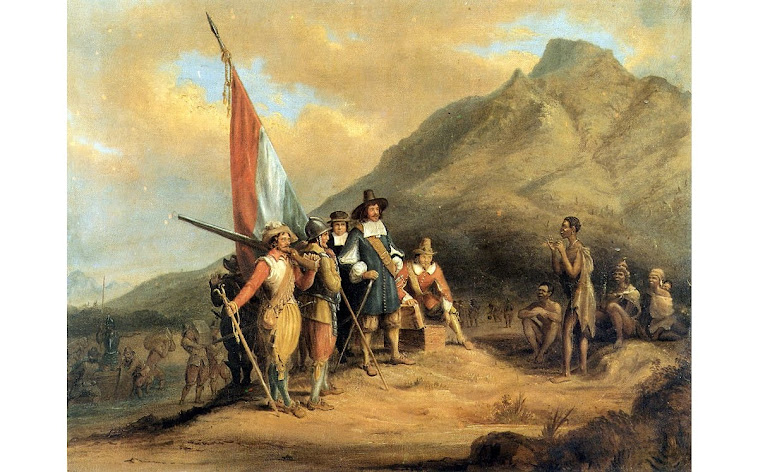Van Riebeeck arrives at the Cape of Good Hope

Thursday 31 January 2013
Date: 28 October, 1629
Maria de la Queillerie van Riebeeck, wife of Jan van Riebeeck who accompanied him to the Cape of Good Hope, is born in Rotterdam, the Netherlands.
Thursday 17 January 2013
First comet
Van Riebeeck reported the first comet discovered from South
Africa, C/1652 Y1, which was spotted on 17 December 1652.

Van Riebeeck was joined at the Cape by a fellow Culemborger
Roelof de Man (1634-1663) who arrived in January 1654 on board the ship
Naerden. Roelof came as the colony bookkeeper and was later promoted to
second-in-charge.
In his time at the Cape, Van Riebeeck oversaw a sustained,
systematic effort to establish an impressive range of useful plants in the
novel conditions on the Cape Peninsula – in the process changing the natural
environment forever. Some of these, including grapes, cereals, ground nuts,
potatoes, apples and citrus, had an important and lasting influence on the
societies and economies of the region.
His daily diary entries kept throughout his time at the Cape (VOC policy) provided the basis for future exploration of the natural environment and its natural resources. Careful reading of his diaries indicate that some of his knowledge was learned from the indigenous peoples inhabiting the region.
Tuesday 15 January 2013
The Castle, which was a Fort
Van Riebeeck was Commander of the Cape from 1652 to 1662; he was charged
with building a fort, with improving the natural anchorage at Table
Bay, planting cereals,fruit and vegetables and obtaining livestock from
the indigenous Khoi people.
In the Kirstenbosch National Botanical Garden in Cape Town there is a Wild Almond hedge still surviving, that was planted on his orders as a protective barrier around the Dutch settlement.

The initial fort, named Fort de Goede Hoop ('Fort of Good Hope') was made of mud, clay and timber, and had four corners or bastions.
This first fort should not be confused with Redoubt Duijnhoop or the Cape Town Castle. The Castle, built between 1666 and 1679, four years after Van Riebeeck's departure, has five bastions and is made of brick, stone and cement. (Zacharias Wagenaer laid the cornerstone of this castle.)
In the Kirstenbosch National Botanical Garden in Cape Town there is a Wild Almond hedge still surviving, that was planted on his orders as a protective barrier around the Dutch settlement.

The initial fort, named Fort de Goede Hoop ('Fort of Good Hope') was made of mud, clay and timber, and had four corners or bastions.
This first fort should not be confused with Redoubt Duijnhoop or the Cape Town Castle. The Castle, built between 1666 and 1679, four years after Van Riebeeck's departure, has five bastions and is made of brick, stone and cement. (Zacharias Wagenaer laid the cornerstone of this castle.)
Monday 14 January 2013
Biography
Jan van Riebeeck (21 April 1619, Culemborg, Gelderland – 18
January 1677) was a Dutch colonial administrator and founder of Cape Town.
Van Riebeeck was born in Culemborg, Netherlands as the son
of a surgeon. He grew up in Schiedam, where he married 19-year old Maria de la
Quellerie on 28 March 1649. (She died in Malacca, now part of Malaysia, on 2
November 1664, at the age of 35). The couple had eight or nine children, most
of whom did not survive infancy. Their son Abraham van Riebeeck, born at the
Cape, later became Governor-General of the Dutch East Indies.
Joining the Vereenigde Oost-Indische Compagnie (VOC) Dutch
East India Company in 1639, he served in a number of posts, including that of
an assistant surgeon in the Batavia in the East Indies. He subsequently visited
Japan. His most important position was that of head of the VOC trading post in
Tonkin, Vietnam. However, he was called back from this post as it was
discovered that he was conducting trade for his own account.
In 1651 he volunteered to undertake the command of the
initial Dutch settlement in the future South Africa. He landed three ships
(Dromedaris; Reijger and Goede Hoop) at the future Cape Town on 6 April 1652
and fortified the site as a way-station for the VOC trade route between the
Netherlands and the East Indies.
The primary purpose of this way-station was to provide fresh
provisions for the VOC fleets sailing between the Dutch Republic and Batavia,
as deaths en route were very high. The Walvisch and the Oliphant arrived later
in 1652, having had 130 burials at sea.
Subscribe to:
Posts (Atom)
